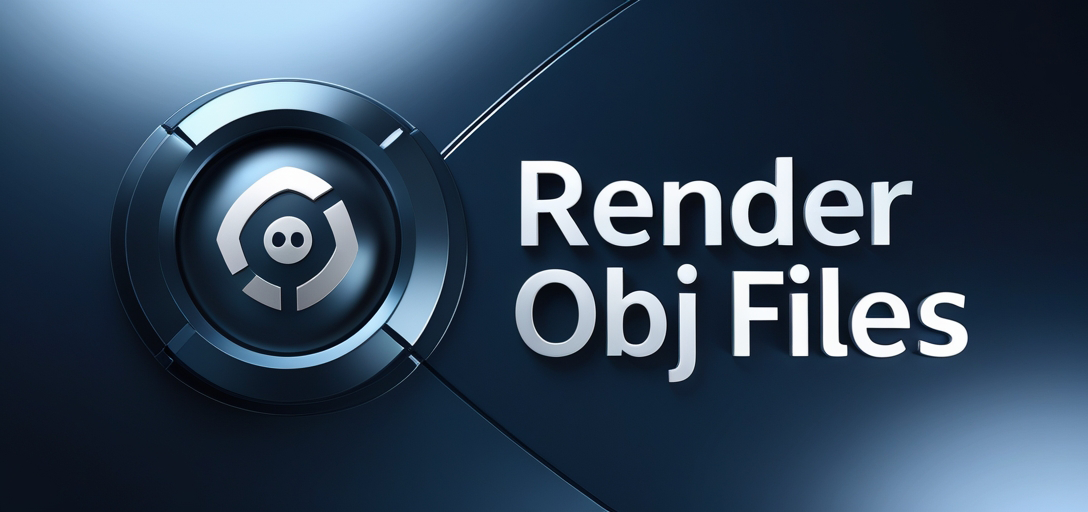Render OBJ Files Using GroupDocs.Viewer .NET
Introduction to Rendering Basics
Rendering 3D objects in various formats is crucial across fields such as architecture, gaming, and design. Converting OBJ files to formats like HTML, JPG, PNG, and PDF can be challenging without the right tools. This tutorial demonstrates how GroupDocs.Viewer .NET simplifies this process.

What You’ll Learn:
- Setting up GroupDocs.Viewer for .NET
- Step-by-step guide on rendering OBJ files to various formats
- Practical applications of rendering 3D objects
- Performance optimization techniques
Prerequisites
Before we begin, ensure you have the following:
Required Libraries and Dependencies
GroupDocs.Viewer for .NET: Ensure you have the latest version installed. Use NuGet Package Manager or .NET CLI.
NuGet Package Manager Console
Install-Package GroupDocs.Viewer -Version 25.3.0.NET CLI
dotnet add package GroupDocs.Viewer –version 25.3.0
### Environment Setup Requirements
- .NET Framework or .NET Core installed on your development machine.
- Visual Studio or any compatible IDE for C# development.
### Knowledge Prerequisites
- Basic understanding of C# programming.
- Familiarity with file handling in C#.
## Setting Up GroupDocs.Viewer for .NET
To start using **GroupDocs.Viewer**, you'll need to install the library and configure your environment. Here's a quick guide:
1. **Install GroupDocs.Viewer**: Use either NuGet Package Manager or .NET CLI as shown above.
2. **License Acquisition**:
- Start with a free trial by downloading from [GroupDocs releases](https://releases.groupdocs.com/viewer/net/).
- For extended use, consider acquiring a temporary license at [Temporary License Page](https://purchase.groupdocs.com/temporary-license/) or purchase a subscription for full access.
3. **Basic Initialization**:
```csharp
using GroupDocs.Viewer;
// Initialize the viewer object
using (Viewer viewer = new Viewer("sample.obj"))
{
// Additional setup if needed
}
This basic setup is your starting point for rendering OBJ files.
Implementation Guide
Let’s explore how to render OBJ documents into different formats using GroupDocs.Viewer.
Rendering OBJ Document to HTML
Overview
Converting an OBJ file to HTML allows you to display 3D models directly in web browsers, enhancing accessibility and sharing capabilities.
Steps:
- Configure Output Path
string outputDirectory = Path.Combine("YOUR_OUTPUT_DIRECTORY", "render_output"); string pageFilePathFormat = Path.Combine(outputDirectory, "obj_result.html"); - Create Viewer Object and Render to HTML
using GroupDocs.Viewer; using System.IO; // Initialize viewer for OBJ file using (Viewer viewer = new Viewer(Path.Combine("YOUR_DOCUMENT_DIRECTORY", "sample.obj"))) { HtmlViewOptions options = HtmlViewOptions.ForEmbeddedResources(pageFilePathFormat); viewer.View(options); // Render to HTML }
Key Configurations: HtmlViewOptions.ForEmbeddedResources() ensures that all resources are embedded within the HTML file.
Rendering OBJ Document to JPG
Overview
JPG images provide a quick preview of your 3D models, ideal for reports and presentations.
Steps:
- Configure Output Path
string pageFilePathFormat = Path.Combine(outputDirectory, "obj_result.jpg"); - Create Viewer Object and Render to JPG
using GroupDocs.Viewer; using System.IO; // Initialize viewer for OBJ file using (Viewer viewer = new Viewer(Path.Combine("YOUR_DOCUMENT_DIRECTORY", "sample.obj"))) { JpgViewOptions options = new JpgViewOptions(pageFilePathFormat); viewer.View(options); // Render to JPG }
Rendering OBJ Document to PNG
Overview
PNG format offers lossless image quality, making it suitable for detailed visual representations.
Steps:
- Configure Output Path
string pageFilePathFormat = Path.Combine(outputDirectory, "obj_result.png"); - Create Viewer Object and Render to PNG
using GroupDocs.Viewer; using System.IO; // Initialize viewer for OBJ file using (Viewer viewer = new Viewer(Path.Combine("YOUR_DOCUMENT_DIRECTORY", "sample.obj"))) { PngViewOptions options = new PngViewOptions(pageFilePathFormat); viewer.View(options); // Render to PNG }
Rendering OBJ Document to PDF
Overview
Creating a PDF version of your 3D model is perfect for archiving or sharing with stakeholders who prefer document formats.
Steps:
- Configure Output Path
string pageFilePathFormat = Path.Combine(outputDirectory, "obj_result.pdf"); - Create Viewer Object and Render to PDF
using GroupDocs.Viewer; using System.IO; // Initialize viewer for OBJ file using (Viewer viewer = new Viewer(Path.Combine("YOUR_DOCUMENT_DIRECTORY", "sample.obj"))) { PdfViewOptions options = new PdfViewOptions(pageFilePathFormat); viewer.View(options); // Render to PDF }
Practical Applications
Rendering 3D models into various formats has numerous applications:
- Architectural Presentations: Architects can convert designs to HTML for easy sharing with clients.
- E-commerce Platforms: Retailers can showcase product details in JPG or PNG format on their websites.
- Technical Documentation: Engineers can include PDF versions of 3D schematics in reports.
Performance Considerations
Optimizing performance is crucial when rendering large OBJ files:
- Use embedded resources for HTML to reduce load times.
- Optimize image quality settings (e.g., resolution) based on use case.
- Manage memory efficiently by disposing of Viewer objects promptly after use.
Conclusion
In this tutorial, you’ve learned how to render OBJ documents into various formats using GroupDocs.Viewer .NET. These skills can enhance your projects by enabling versatile presentation and sharing of 3D models. Next steps could include exploring additional features offered by GroupDocs.Viewer or integrating it with other systems for more complex workflows.
FAQ Section
- Can I render OBJ files to formats other than HTML, JPG, PNG, and PDF?
- Currently, these are the primary formats supported directly. However, you can convert rendered images into other formats using additional libraries.
- What is the best format for sharing 3D models online?
- HTML is ideal due to its compatibility with web browsers, allowing interactive viewing without extra plugins.
- How do I manage large OBJ files efficiently?
- Optimize file size before rendering and utilize embedded resources in HTML to improve load times.
- Is GroupDocs.Viewer free for commercial use?
- A trial version is available; for commercial use, you need a purchased license or temporary license.
- Can I customize the output quality of images rendered with GroupDocs.Viewer?
- Yes, adjust resolution settings in
JpgViewOptionsandPngViewOptionsto meet your quality requirements.
- Yes, adjust resolution settings in
Resources
- Documentation
- API Reference
- Download GroupDocs.Viewer
- Purchase License
- Free Trial
- Temporary License
- Support Forum
Start exploring these features and see how they can benefit your projects!